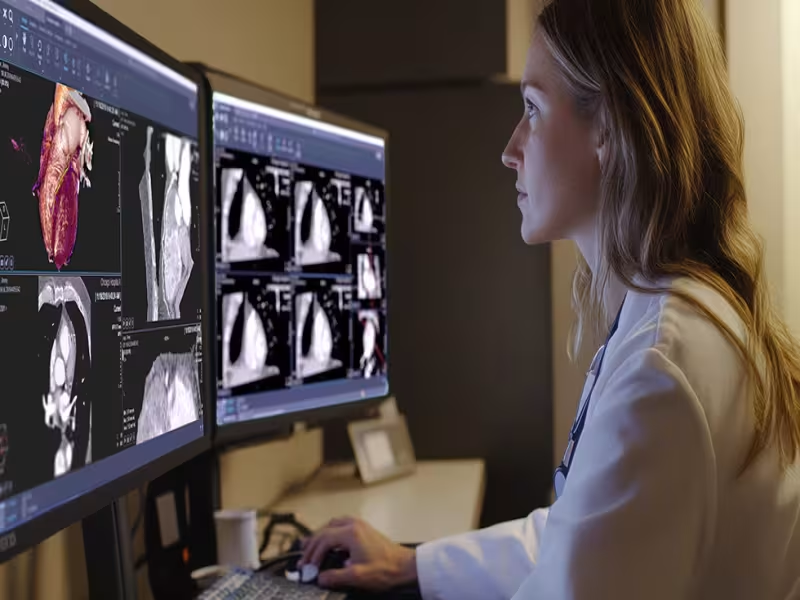
SHERIDAN, WYOMING - November 25, 2025 - Royal Philips has launched Image Management 15, the next generation of its Philips Vue PACS platform, featuring a zero-footprint web diagnostic viewer that brings full radiology workstation capabilities into a standard web browser. Positioned as a cornerstone of Philips' cloud-enabled imaging informatics strategy, the solution is designed to help health systems modernize remote reading, streamline AI integration, and simplify IT across distributed radiology networks.
Anywhere, anytime diagnostic reading via the browser
The new web-based diagnostic viewer is built to address one of radiology's most persistent pain points: lost clinical time due to slow performance and fragmented remote reading setups. Delivering high-performance server-side rendering and workflow automation, it allows radiologists to access advanced clinical tools securely through a browser, without local installation.
"We were among the first to test the new Philips web-based diagnostic viewer, and the difference is clear. It loads studies quickly and runs smoothly, even with large datasets. The new interface is intuitive and lets us focus entirely on the images, a real step forward in performance and usability," said Pieter Hoste, Chief Radiologist and Head of Medical Imaging, AZ West Hospital, Belgium.
By optimizing processing between client and server, the viewer supports large and complex datasets such as digital breast tomosynthesis and cardiac CT, maintaining consistent performance whether radiologists are on-site, reading across the enterprise, or working remotely.
Integrated AI and reporting to streamline workflows
Beyond access, the viewer is engineered as a hub for integrated diagnostics. It interfaces with connected AI tools so that imaging, AI findings and relevant patient information can be brought together in a single environment, helping radiologists move faster from image review to decision.
Natively connected to an interactive reporting module, the viewer manages reporting within the PACS workflow, removing the need for separate dictation or reporting systems. Radiologists can interpret studies and generate comprehensive reports without leaving their primary reading application, reducing context switching and potential errors.
The redesigned user interface exposes a full suite of advanced clinical applications and accelerates reading by aligning images across modalities and time points. When combined with the Philips Advanced Visualization Workspace, deeper analysis results can be embedded directly into the reporting workflow, further boosting efficiency and productivity for complex cases.
Cloud-enabled deployment through HealthSuite and AWS
Image Management 15 and its web diagnostic viewer are built for cloud deployment on Philips HealthSuite, powered by Amazon Web Services (AWS), with an on-premises option for organizations that need or prefer local hosting. This hybrid flexibility allows health systems to preserve existing infrastructure investments while charting their own path to the cloud.
"Health systems are under intense pressure to do more with less. The web diagnostic viewer is a milestone in our journey toward cloud-enabled, AI-integrated diagnostic imaging. It brings the power of advanced visualization, collaboration, and intelligence to any browser, helping radiologists stay connected and productive wherever care happens while streamlining IT operations," said Madhuri Sebastian, Business Leader Imaging Informatics at Philips.
The SaaS deployment model on HealthSuite delivers built-in security, effortless scalability across multiple sites, and consistent performance for teams working on-site, remotely or across borders. Initially available in the USA, Philips plans to expand the solution to additional regions in 2026, aligning with global demand for cloud-based radiology platforms.
Strategic impact for imaging IT and enterprise radiology
For CIOs, imaging IT leaders and radiology directors, Philips Image Management 15 represents a shift from workstation-centric to browser-centric diagnostics, underpinned by cloud architecture and AI integration. Key strategic benefits include:
- Standardized diagnostic experience across locations and devices
- Simplified deployment, upgrades and lifecycle management via SaaS
- Tighter integration of AI, visualization and reporting in one workflow
- A scalable foundation for cross-site collaboration and enterprise teleradiology
As imaging volumes grow and radiology teams become more distributed, the combination of zero-footprint access, AI-ready workflows and cloud-native scalability positions Philips' new web-based viewer as a building block for the next generation of connected radiology services.
Showcasing cloud, AI and agentic workflows at RSNA 2025
At RSNA 2025, Philips will showcase the new web diagnostic viewer as part of a broader imaging informatics and AI ecosystem. Demonstrations will highlight how generative AI can automate tasks such as display protocol normalization and patient summaries, while Agentic AI supports anatomy-aware automation for study prioritization and workflow orchestration. Together, these capabilities underline Philips' ambition to make radiology more efficient, more connected and more resilient to workforce and volume pressures.
For more information about Philips Image Management 15, the new web-based diagnostic viewer and Philips' broader imaging informatics portfolio, visit https://www.philips.com/global.